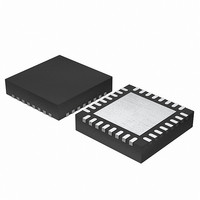EFM32G200F16 Energy Micro, EFM32G200F16 Datasheet - Page 150

EFM32G200F16
Manufacturer Part Number
EFM32G200F16
Description
MCU 32BIT 16KB FLASH 32-QFN
Manufacturer
Energy Micro
Series
Geckor
Datasheets
1.EFM32G200F16.pdf
(63 pages)
2.EFM32G200F16.pdf
(10 pages)
3.EFM32G200F16.pdf
(463 pages)
4.EFM32G200F16.pdf
(136 pages)
Specifications of EFM32G200F16
Core Processor
ARM® Cortex-M3™
Core Size
32-Bit
Speed
32MHz
Connectivity
EBI/EMI, I²C, IrDA, SmartCard, SPI, UART/USART
Peripherals
Brown-out Detect/Reset, DMA, POR, PWM, WDT
Number Of I /o
24
Program Memory Size
16KB (16K x 8)
Program Memory Type
FLASH
Ram Size
8K x 8
Voltage - Supply (vcc/vdd)
1.8 V ~ 3.8 V
Data Converters
A/D 4x12b, D/A 1x12b
Oscillator Type
External
Operating Temperature
-40°C ~ 85°C
Package / Case
32-VQFN Exposed Pad
Processor Series
EFM32G200
Core
ARM Cortex-M3
Data Bus Width
32 bit
Data Ram Size
8 KB
Interface Type
I2C, UART
Maximum Clock Frequency
32 MHz
Number Of Programmable I/os
24
Number Of Timers
2
Operating Supply Voltage
1.8 V to 3.8 V
Maximum Operating Temperature
+ 85 C
Mounting Style
SMD/SMT
Minimum Operating Temperature
- 40 C
Lead Free Status / RoHS Status
Lead free / RoHS Compliant
Eeprom Size
-
Lead Free Status / Rohs Status
Details
- EFM32G200F16 PDF datasheet
- EFM32G200F16 PDF datasheet #2
- EFM32G200F16 PDF datasheet #3
- EFM32G200F16 PDF datasheet #4
- Current page: 150 of 463
- Download datasheet (8Mb)
15.3.7.2 Interactions
2010-09-06 - d0001_Rev1.00
Whenever the I
all bus activities, and the BUSHOLD interrupt flag in I2Cn_IF is set. The action(s) required by software
depends on the current state the of the I
As an example, Table 15.4 (p. 152) shows the different states the I
as a Master Transmitter, i.e. a master that transmits data to a slave. As seen in the table, when a start
condition has been transmitted, a requirement is that there is an address and an R/W bit in the transmit
buffer. If the transmit buffer is empty, then the BUSHOLD interrupt flag is set, and the bus is held until
data becomes available in the buffer. While waiting for the address, I2Cn_STATE has a value 0x57,
which can be used to identify exactly what the I
Note
The different interactions used by the I
a set of different courses of action are possible from a given state, the course of action using the highest
priority interactions, that first has everything it is waiting for is the one that is taken.
Table 15.3. I
The commands marked with a * in Table 15.3 (p. 150) can be issued before an interaction is required.
When such a command is issued before it can be used/consumed by the I
Interaction
STOP*
ABORT
CONT*
NACK*
ACK*
ADDR+W -> TXDATA
ADDR+R -> TXDATA
START*
TXDATA
RXDATA
None
The bus would never stop at state 0x57 if the address was available in the transmit buffer.
2
C Interactions in Prioritized Order
2
C module is waiting for interaction from software, it holds the bus clock SCL low, freezing
Priority
1
2
3
4
5
6
7
8
9
10
11
2
2
C module are listed in Table 15.3 (p. 150) in prioritized order. If
C module. This state can be read from the I2Cn_STATE register.
2
...the world's most energy friendly microcontrollers
C module is waiting for.
150
Software action
Set the STOP command bit
in I2Cn_CMD
Set the ABORT command bit
in I2Cn_CMD
Set the CONT command bit
in I2Cn_CMD
Set the NACK command bit
in I2Cn_CMD
Set the ACK command bit in
I2Cn_CMD
Write an address to the
transmit buffer with the R/W
bit set
Write an address to the
transmit buffer with the R/W
bit cleared
Set the START command bit
in I2Cn_CMD
Write data to the transmit
buffer
Read data from receive
buffer
No interaction is required
2
C goes through when operating
2
C module, the command is
Automatically continues if
PSTOP is set (STOP
pending) in I2Cn_STATUS
Never, the transmission is
aborted
PCONT is set in
I2Cn_STATUS (CONT
pending)
PNACK is set in
I2Cn_STATUS (NACK
pending)
AUTOACK is set in
I2Cn_CTRL or PACK is
set in I2Cn_STATUS (ACK
pending)
Address is available in
transmit buffer with R/W bit
set
Address is available in
transmit buffer with R/W bit
cleared
PSTART is set in
I2Cn_STATUS (START
pending)
Data is available in transmit
buffer
Space is available in receive
buffer
www.energymicro.com
Related parts for EFM32G200F16
Image
Part Number
Description
Manufacturer
Datasheet
Request
R

Part Number:
Description:
KIT STARTER EFM32 GECKO
Manufacturer:
Energy Micro
Datasheet:

Part Number:
Description:
KIT DEV EFM32 GECKO LCD SUPPORT
Manufacturer:
Energy Micro
Datasheet:

Part Number:
Description:
BOARD PROTOTYPING FOR EFM32
Manufacturer:
Energy Micro
Datasheet:

Part Number:
Description:
KIT DEVELOPMENT EFM32 GECKO
Manufacturer:
Energy Micro
Datasheet:

Part Number:
Description:
MCU, MPU & DSP Development Tools TG840 Sample Kit
Manufacturer:
Energy Micro
Datasheet:

Part Number:
Description:
MCU, MPU & DSP Development Tools TG Starter Kit
Manufacturer:
Energy Micro
Datasheet:

Part Number:
Description:
MCU, MPU & DSP Development Tools TG108 Sample Kit
Manufacturer:
Energy Micro

Part Number:
Description:
MCU, MPU & DSP Development Tools TG210 Sample Kit
Manufacturer:
Energy Micro
Datasheet:

Part Number:
Description:
MCU, MPU & DSP Development Tools TG822 Sample Kit
Manufacturer:
Energy Micro
Datasheet:

Part Number:
Description:
MCU, MPU & DSP Development Tools TG230 Sample Kit
Manufacturer:
Energy Micro

Part Number:
Description:
SAMPLE KIT (SMALL BOX - CONTAINING 2 DEVICES)
Manufacturer:
Energy Micro

Part Number:
Description:
SAMPLE KIT (SMALL BOX - CONTAINING 2 DEVICES)
Manufacturer:
Energy Micro










